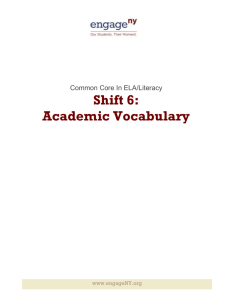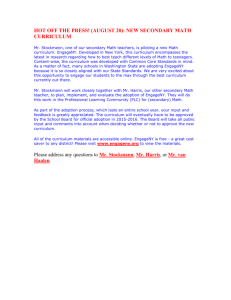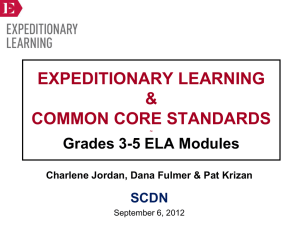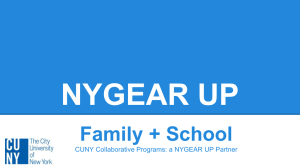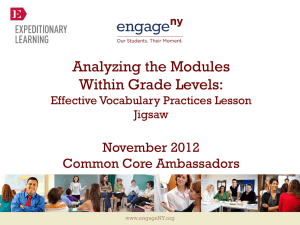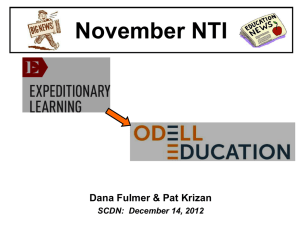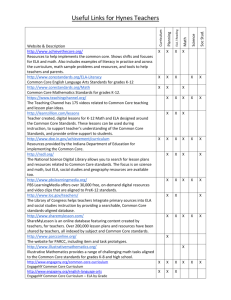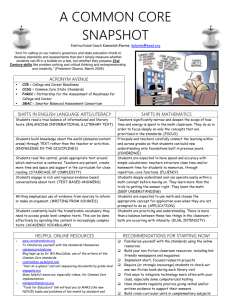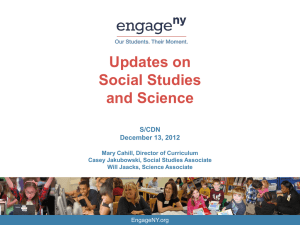NYSED Common Core Implementation
advertisement
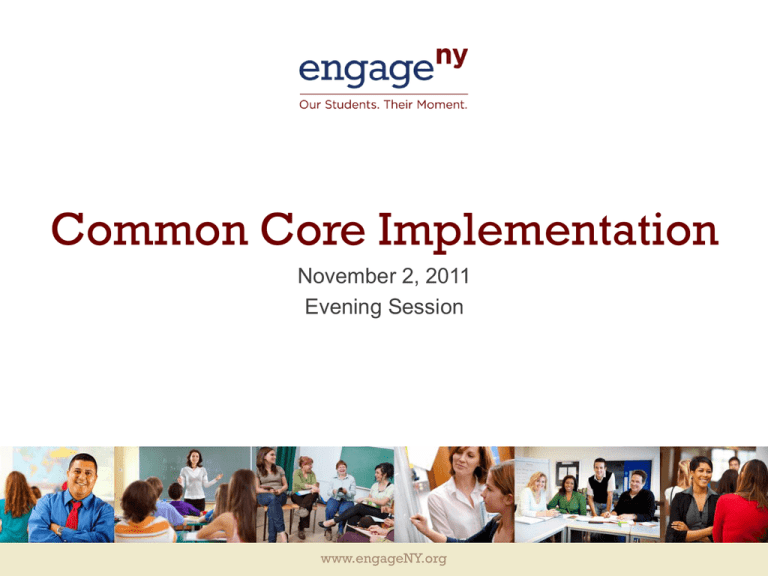
Common Core Implementation November 2, 2011 Evening Session www.engageNY.org 3 Initiatives Data Driven Instruction Teacher/ Leader Effectiveness College & Career Ready Students www.engageNY.org Common Core State Standards 2 Graduation Rates in New York State* New York State Graduation Rates 100% 90% Graduation Rate 80% 84% 73% 70% 58% 60% 57% Graduation Rate 51% 50% 40% ELA/Math Aspirational Performance Measure (APM) 37% 30% 20% 15% 13% 10% 0% All White Black Hispanic Student Subgroup * 2006 cohort, four-year outcomes through June Source: NYSED Office of Information and Reporting Services www.engageNY.org 3 College Instructors and Employers Say Graduates Are Not Prepared for College and Work Average estimated proportions of recent high school graduates who are not prepared 100% 75% 50% 42% 45% College Instructors Employers 25% 0% Source: Peter D. Hart Research Associates/Public Opinion Strategies, Rising to the Challenge: Are High School Graduates Prepared for College and Work? prepared for Achieve, Inc., 2005. www.engageNY.org 4 International Competitiveness % 70 College and university graduation rates in 1995 and 2006 (first-time graduation) 2006 60 50 1995 2nd Decline in relative position of U.S. from 1995 to 2006 15th 40 30 20 10 Iceland1 Australia1 New Zealand1 Finland1 Poland1 Denmark1 Netherlands1 Norway1 Sweden1 Italy Ireland United Kingdom1 Japan OECD average Israel United States EU19 average Canada1,2 Slovak Republic1 Portugal1 Spain Hungary Switzerland1 Czech Republic1 Austria1 Germany1 Slovenia Greece1 Turkey 0 1. Net graduation rate is calculated by summing the graduation rates by single year of age in 2006. 2. Year of reference 2005. Countries are ranked in descending order of the graduation rates for tertiary-type A education in 2006. Source: OECD. Table A3.2 See Annex 3 for notes (www.oecd.org/edu/eag2008 ) www.engageNY.org Three Paths Forward Scenario #1 Slow cuts that work to erode public education Scenario #2 Tinker around the edges, trying to protect students and learning Scenario #3 Redesign schooling to improve processes and outcomes, and sustainability Source: Marguerite Roza, September 13, 2011 Presentation to School Finance Symposium hosted by the Board of Regents. www.engageNY.org 6 Productivity Curve Source: Marguerite Roza, September 13, 2011 Presentation to School Finance Symposium hosted by the Board of Regents. www.engageNY.org 7 NAEP Reading Average Scale Score NAEP Reading Results 280 270 260 250 264 266 275 255 240 230 220 210 271 231 237 220 222 211 Grade 4 MA MD NY U.S. CA MA MD NY U.S. CA 200 Grade 8 Source: Nationally representative samples of about 213,000 fourth-graders and 168,000 eighth-graders participated in the 2011 Nationalwww.engageNY.org Assessment of 8 NAEP Math NAEP Math Results Average Scale Score 320 299 300 273 280 260 240 240 234 238 247 288 283 280 253 220 Grade 4 Source: Nationally representative samples of about 213,000 fourth-graders and 168,000 eighth-graders participated in the 2011 Nationalwww.engageNY.org Assessment of MA MD U.S. NY CA MA MD U.S. NY CA 200 Grade 8 9 NY State Test Item 5th Grade Math (2005) www.engageNY.org Example Common Core Performance Task 5th Grade Math www.engageNY.org Example Annotated Student Work www.engageNY.org NY State Test Item English Language Arts (2005) www.engageNY.org Example Common Core Performance Task English Language Arts & Literacy Richard Wright struggles to find his ‘place’ in society. He refuses to forgo his morality and beliefs to conform to the status quo. Examine Wright’s pride. Find examples in the text that demonstrate the influence pride has on Wright’s actions. How does his pride influence his decisions? Is pride a positive or negative influence in Wright’s life? How does Wright’s pride affect how his family members treat him?” www.engageNY.org Example Annotated Student Work Wright’s pride prompts him to make principled decisions and carry out actions that illustrate his morality and inherent beliefs. Wright refuses to neglect his values and chooses right over wrong even when he recognizes that failure to adhere to what is expected of him will ultimately result in negative and often violent consequences. When he receives the title of valedictorian and refuses to read the speech prepared for him by his principal, choosing instead to present his own speech in spite of the threat of being held back, Wright’s pride is demonstrated. Although he comprehends the consequences and the gravity of his decision, Wright refuses to compromise his beliefs: “I know that I’m not educated, professor . . . But the people are coming to hear the students, and I won’t make a speech that you’ve written” (174). Though urged by his family members and his classmates to avoid conflict and to comply with the principal’s demand, Wright refuses because he does not believe it is the morally correct thing to do…. www.engageNY.org The Student organizes complex ideas, concepts, and information so that each new element builds on that which precedes it to create a unified whole. Student uses appropriate and varied transitions and syntax to link the major sections of the text, create cohesion, and clarify the relationships among complex ideas and concepts. The Student develops the topic thoroughly by selecting the most significant and relevant facts, extended definitions, concrete details, quotations, or other information and examples knowledge of the topic. Example Common Core Performance Task English Language Arts & Literacy You have read information from three sources about media in daily life or in world affairs. When you consider what all these different sources say about the effects of media use: What are the gains? What are the dangers for the lives of young people? And for a larger society? Write a short (750 words) essay in which you: Explain what's at stake: Why does this issue matter? Develop and state your own position. Defend your position with a range of different types of evidence (interviews, research data, and newspaper reports, etc.). www.engageNY.org 16 Example Annotated Student Work Student uses appropriate and varied transitions and syntax to link the major sections of the text, create cohesion, and clarify the relationships among complex ideas and concepts. Student establishes and maintains a formal style and objective tone while attending to the norms and conventions. ….Furthermore, Facebook, YouTube, and MySpace are a few examples of social networking that pull youth off track. For example, in "Fast Times at Woodside High", Vishnal a bright 17teen year old was not able to finish the book Kurt Vonnegut's Cat's Cradle, his summer reading assignment, but he managed to read only 43 pages in two months. Vishnal's lack of academic proficiency was due to Facebook and creating videos for YouTube. Additionally, according to "Media Use" children spend two hours and 46 minutes on average on the computer and about 48 minutes reading. This shows us that kids are losing their educational interest because of the media. Also the youth are not being productive enough sitting in front of a TV screen. According to Smith, for each “additional hour a student watches TV, they 5 times less likely to participate in school sports”. This can also lead to health issues and result in obese children, because kids no longer want to participate in activities outside but instead sit and watch TV. www.engageNY.org The Student develops the topic thoroughly by selecting the most significant and relevant facts, extended definitions, concrete details, quotations, or other information and examples knowledge of the topic. Phased State Level Implementation of the Core Live David Coleman Webinar, Gettysburg, EngageNY.org Initial Training, The Shifts, PBS Video Series & PD Suggestions EngageNY 1.1, Sample Modules, Professional Development Kit, Tri-State Rubric & Jury, Road Show Ongoing Network Team Training Intensive Teacher Training, Engage 2.0, “Effective Teacher” Practice Videos, “Developing Teacher” Practice Videos, DDI Cycle Videos, Curricular Modules www.engageNY.org 18 Phased School Level Implementation of the Core Awareness Capacity Building, Intensive PD, Problem Solving in Teams, Unit Per Semester 1 Full Implementation, Aligned Assessments (Formative, Interim/ Periodic, Summative) www.engageNY.org 19 One Unit Each Semester… www.engageNY.org 20 Engage NY v1.1 www.engageNY.org 21 EngageNY 1.1 Step What to Do What to Read or Watch Get the Big Picture Step 1 Have to create this resource. Read about the Common Core State Standards, why they matter and how they apply to New York State. Understand the New Standards Step 2 Step 3 Step 4 Become familiar with the New York State Common Core Learning Standards. Identify the Key Shifts Understand the major shifts in instruction the NYS Common Core Learning Standards demands compared to the 2005 Standards. Then, watch the video series on your content area to learn, specifically, what actions you can take to implement those shifts. Know the Tests Look at the assessment roll out calendar and learn about the ways the tests will shift in alignment with each of the Common Core shifts. NYS P-12 Common Core Learning Standards Common Core Shifts Common Core Video Series Assessment Roll Out Calendar and Information Get Practical Step 5 Step 6 Step 7 Curriculum Exemplars Read some detailed examples of ways to teach the Common Core in the classroom. Train Your Staff Use the videos and PD recommendations to train your staff about the NYS P-12 Learning Standards Ensure the Success of Your Teachers in Implementation Read about specific actions you can take to implement each of the shifts in the classrooms of your building. Common Core Shifts Common Core Video Series PD Outlines What the principal should do slides www.engageNY.org What You’ll Have Learned You’ll know the basics about Common Core standards, how New York plans to implement them and when your students will be tested on them. You’ll know what your students will be expected to know for your subject and grade level. You’ll know the primary ways the Common Core Learning Standards are different from the current New York State Standards- and you’ll know some specific actions to help in implementation. You’ll know what to anticipate and when regarding the changes in state assessments. You’ll know what sample instructional planning can look like to lead students to success against the Common Core Learning Standards. You’ll have some ideas about how to use the videos to structure professional development for your staff members. You’ll know what you can do to ensure effective implementation in your classrooms 22 Math Module- First Grade www.engageNY.org PD Kit www.engageNY.org 24 ELA/ Literacy Rubric Superior (3) ELA Criteria Alignment with CCSS Building Disciplinary Knowledge through Informational and Literary Texts Staircase of Complexity Text-Based Answers/Evid ence-Based Conversations and Writing Writing from Sources Academic Vocabulary DRAFT The unit has a clear laser-like focus on a few targeted standards in order to develop deeper conceptual understanding of the knowledge and skills addressed. Major content and performance expectations in the targeted standard(s) are completely addressed in the unit at the level of rigor in the CCSS. The lesson(s) require(s) students to use as well as integrate reading, writing, speaking and listening. In some lessons, technology and media are used as appropriate to support teaching and learning of the targeted CCSS. The materials require that students be engaged with a balance of domain specific/ informational and literary texts through close analytic readings, comparison and synthesis of information, and evidence-based responses. Selections for the unit should be coherent so that students can build knowledge about a topic or subject and include short and long readings. Short and long readings may be selected from science, social studies, the arts or literature and at grade 6-12 include literary nonfiction. The unit materials are focused on all students reading the grade level appropriate text around which instruction is centered (identified in Appendix A in the CCSS). The unit provides sufficient time for students reading below grade level to grapple with complex text to build proficiency. The materials provide sufficient scaffolding and the high quality support that are necessary for students reading below grade level. The unit provides specific, thought-provoking questions that engage students in rich and rigorous conversations that require answers that are supported with evidence from the text. When appropriate, students may be required to compare and contrast (synthesize /integrate) some of the readings as they progress through the unit. Students are required to make evidentiary arguments in conversation as well as construct the same in writing. The unit requires that students’ writing emphasize use of evidence to inform/ explain or make an argument (in grades 6-12) rather than using a form of de-contextualized prompt such as personal narrative. The lesson requires students to use evidence to inform/explain or make an argument in response to ideas, events, facts, and arguments presented in texts. Students are required to produce a research project in order to demonstrate their ability to write for research. Students’ writing must exhibit awareness of audience and multiple points of view. A balance of on-demand and process writing is evident across the unit. The unit provides the opportunity for students to continually build the vocabulary they need to access the specific grade level complex texts that they are required to read. The unit establishes an expectation that students have experiences/ opportunities to utilize vocabulary throughout writing, speaking & listening. 25 www.engageNY.org DRAFT Mathematics Rubric Superior (3) Mathematics Criteria (1) Alignment with CCSS All content and performance expectations in the targeted standard(s) are completely addressed in the unit at the level of rigor in the CCSS. Standards for mathematical practice are embedded and integrated in the unit. Technology and media are used as appropriate to support teaching and learning of the targeted CCSS. (1) Focus The unit is narrowly focused on strong foundational knowledge and deep conceptual understanding of priority standards; mathematical practice(s) are included. The materials provide the opportunity for students to transfer mathematical skills and understanding across concepts and grades. (1) Coherence (1) Fluency The unit includes a description of prior knowledge and the conceptual understanding of core content built in previous years, that provides the foundation for the unit and builds connections to students’ future learning. Knowledge, skills, abilities, and learning opportunities are linked with one another and the targeted CCSS (i.e. a clear linear progression is evident in the unit toward the standard). Unit materials build upon students’ deep understanding to develop and reinforce their speed and accuracy with simple calculations that involve core functions. The unit provides guidelines for how class time might be structured to include opportunities for students to build fluency with core functions so that they are able to understand more complex concepts. www.engageNY.org 26 NY State Test Item 5th Grade Math (2005) www.engageNY.org Example Common Core Performance Task 5th Grade Math www.engageNY.org Example Annotated Student Work www.engageNY.org NY State Test Item English Language Arts (2005) www.engageNY.org Example Common Core Performance Task English Language Arts & Literacy Richard Wright struggles to find his ‘place’ in society. He refuses to forgo his morality and beliefs to conform to the status quo. Examine Wright’s pride. Find examples in the text that demonstrate the influence pride has on Wright’s actions. How does his pride influence his decisions? Is pride a positive or negative influence in Wright’s life? How does Wright’s pride affect how his family members treat him?” www.engageNY.org Example Annotated Student Work Wright’s pride prompts him to make principled decisions and carry out actions that illustrate his morality and inherent beliefs. Wright refuses to neglect his values and chooses right over wrong even when he recognizes that failure to adhere to what is expected of him will ultimately result in negative and often violent consequences. When he receives the title of valedictorian and refuses to read the speech prepared for him by his principal, choosing instead to present his own speech in spite of the threat of being held back, Wright’s pride is demonstrated. Although he comprehends the consequences and the gravity of his decision, Wright refuses to compromise his beliefs: “I know that I’m not educated, professor . . . But the people are coming to hear the students, and I won’t make a speech that you’ve written” (174). Though urged by his family members and his classmates to avoid conflict and to comply with the principal’s demand, Wright refuses because he does not believe it is the morally correct thing to do…. www.engageNY.org The Student organizes complex ideas, concepts, and information so that each new element builds on that which precedes it to create a unified whole. Student uses appropriate and varied transitions and syntax to link the major sections of the text, create cohesion, and clarify the relationships among complex ideas and concepts. The Student develops the topic thoroughly by selecting the most significant and relevant facts, extended definitions, concrete details, quotations, or other information and examples knowledge of the topic. Example Common Core Performance Task English Language Arts & Literacy You have read information from three sources about media in daily life or in world affairs. When you consider what all these different sources say about the effects of media use: What are the gains? What are the dangers for the lives of young people? And for a larger society? Write a short (750 words) essay in which you: Explain what's at stake: Why does this issue matter? Develop and state your own position. Defend your position with a range of different types of evidence (interviews, research data, and newspaper reports, etc.). www.engageNY.org 33 Example Annotated Student Work Student uses appropriate and varied transitions and syntax to link the major sections of the text, create cohesion, and clarify the relationships among complex ideas and concepts. Student establishes and maintains a formal style and objective tone while attending to the norms and conventions. ….Furthermore, Facebook, YouTube, and MySpace are a few examples of social networking that pull youth off track. For example, in "Fast Times at Woodside High", Vishnal a bright 17teen year old was not able to finish the book Kurt Vonnegut's Cat's Cradle, his summer reading assignment, but he managed to read only 43 pages in two months. Vishnal's lack of academic proficiency was due to Facebook and creating videos for YouTube. Additionally, according to "Media Use" children spend two hours and 46 minutes on average on the computer and about 48 minutes reading. This shows us that kids are losing their educational interest because of the media. Also the youth are not being productive enough sitting in front of a TV screen. According to Smith, for each “additional hour a student watches TV, they 5 times less likely to participate in school sports”. This can also lead to health issues and result in obese children, because kids no longer want to participate in activities outside but instead sit and watch TV. www.engageNY.org The Student develops the topic thoroughly by selecting the most significant and relevant facts, extended definitions, concrete details, quotations, or other information and examples knowledge of the topic. Timeline for Availability of Sample Test Items • 2012-13 • Grade 3-8 NYS English Language Arts: Summer 2012 • Grades 3-8 NYS Mathematics: Summer 2012 • Grades 9-10 NYS English Language Arts (if funding available): Summer 2012 • 2013-14 • Algebra I: Summer 2012 • 2014-15 (if PARCC adopted by the Board of Regents) • PARCC 3-11 English Language Arts & Literacy: Summer 2013 • PARCC 3-11 Mathematics: Summer 2013 www.engageNY.org Scope & Sequence for CCSS PD in 11/12 Month November Date Nov 29 Content Area Standards Nov 29 Night Session Nov 30 March 12 Night Session Standards April April 16 Night session CCSS Content Workshop Shakespeare May May 14 May 14 Night Session July 9-13 Standards Standards ELA Shifts 4, 5, 6 Language of Power March July Standards Standards Topic ELA Shift 1, 2 (Text Pairs, Teacher Practice) ELA Shift 1 (Content Knowledge) Math ELA Shift 3 (lexiles +, scaffolding, quadrad) CCSS Math Module Workshop for Teachers/Principals CCSS ELA Module Workshop for Teachers/ Principals www.engageNY.org 3 Initiatives for Network Teams – Yr 2 36 Content Expertise – Think, Pair Share Table Discussions • In what content am I an expert? • How many adult conversations have I had (since school started) about the content I teach? • What are the criteria for a productive, enriching adult conversation about content? www.engageNY.org Looking at Student Work – Working Together 1. 2. 3. 4. Assemble in grade level groups of 3. Collect all of the writing samples for your grade. Assign a recorder for your group. Create a T chart and draw conclusions about the student work: What do these students know? What can these students do? www.engageNY.org 38 Looking at Student Work Is there a gap between the work currently being produced in your school at this grade level than the student work in the Appendix of the Common Core State Standards? If so, what is it? What are the implications for our practice? www.engageNY.org 39
